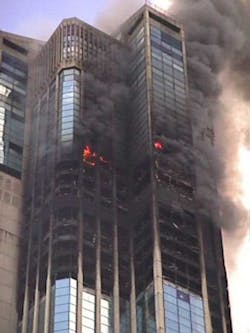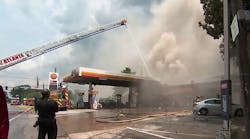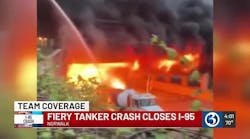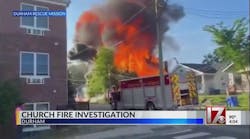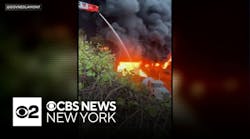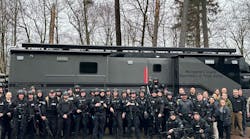While high-rise building construction and development have existed since the beginning of the 20th century in parts of the United States, such as New York City, many other parts of the globe began building toward the sky only in the last two or three decades. Some reasons for this: 1) There’s a lack of construction space in crowded, urban areas, and 2) builders often want to use a more modern type of architecture.
And with changes to a city’s skyline comes a new challenge to fire departments—the development of high-rise structures in jurisdictions that have never faced a high-rise inferno, such as the 1988 Los Angeles City Interstate Bank Fire, the 1980 Las Vegas MGM Grand Hotel Fire, the 1981 Hilton Las Vegas Fire or the 1991 One Meridian Plaza Fire in Philadelphia. The list goes on and on. The question the international fire service community must then ask itself is, how will less experienced, less regulated cities combat similar incidents in the future?
Safety and regulations
In recent years, we’ve seen more fires that spread rapidly through a building’s entire external cladding (e.g., the New Year’s Eve Address Downtown Hotel Fire in Dubai); as a result, fire departments don’t stand a chance of containing the flames. In contrast, firefighting efforts are more efficient in an interior floor and/or compartment fire, where flame spread depends on the structure’s interior layout.
In the former scenario, first-in fire companies face a very large incident, with flames at times spreading beyond the reach of master streams or aerial ladders. The fire can spread vertically and can penetrate to the structure’s interior compartments. This occurs because substandard regulations are placed on external building materials; as a result, builders use polystyrene or polyethylene as insulation sheets for covering exterior walls.
The Venezuela example
The water supply to hydrants inside and around high-rise buildings is one of the biggest issues in fighting fires high above ground level. Of course, one of the most recognized U.S. incidents related to this issue is the 1991 One Meridian Plaza Fire. At the time of that fire, the building was only partially protected by automatic sprinklers.
A similar incident occurred on Oct. 18, 2004, when fire broke out around midnight on the 34th floor of the east tower of the Parque Central office building, a 54-story structure in Caracas, Venezuela. The building was equipped with a sprinkler system, but it had been de-activated due to leakage and maintenance issues. First-arriving crews tried to pump the standpipe system but weren’t able to flow any water through it; a lack of maintenance made the system inoperable. Commanders at the scene then decided to stretch a 2.5-inch (65-mm) hoseline fed by fire engines through the entire stairwell, using two portable pumps to maintain adequate pressures above the 34th floor. Firefighters were also able to operate two 1.5-inch (38-mm) hoselines and slow the fire spread. Two hours later, a second 2.5-inch line was stretched in a position identical to the first one. This strategy proved successful until approximately 7 a.m., when the pumps started to malfunction, causing the fire to intensify and spread to the 17 floors above. At that point, firefighting efforts were stopped due to concern of building collapse.
This incident is a reminder of what can happen with an unreliable or unmaintained fire protection system. The good news: Many building regulations in jurisdictions around the globe are now requiring the inclusion of state-of-the-art fire protection systems; fortunately, many systems are constructed in accordance with NFPA standards. However, these systems aren’t always checked, and as the years pass, if left unchecked, we may face yet another high-rise disaster.
In a high-rise fire, we’re totally dependent on sprinkler and standpipe systems. If they fail, firefighters are forced to take a less effective approach, sometimes having to stretch hoselines through dozens of floors to reach the seat of the fire.
When I discussed this issue with colleagues from around the world, I found that we share the same concerns regarding high-rise buildings and water supply issues, especially in cases of residential towers where there are limits placed on fire prevention regulations. Residents’ economic issues can also play a role in the safety of some residential towers, making firefighting even harder.
The European approach
The United States is known for favoring high-flow rate attack lines. In Europe, however, the approach is geared more toward smaller handlines and the use of fog nozzles for gas (smoke) cooling techniques (known as 3-D firefighting). This approach uses flow rates of 30–60-gpm (115–230 lpm) to create short bursts of water in an effort to cool down the fire gases and prevent flashover, backdraft or fire gas ignitions (also known as a smoke explosion or flash fires). This approach is based on a nozzle pressure of 100 psi (7 bar—low pressure), which is optimal for gas cooling when using standard hoselines. In Europe, there are some departments that use high-pressure reels of 40-60 bar.
Other differences exist between the U.S. approach and the European approach to firefighting, but in the field of high-rise firefighting, the majority of buildings are built from fire-resistant materials from around the world; even the construction methods are pretty much the same. To determine the specific differences in firefighting approach, let’s consider the interior core of the modern office building and the open floor space around it as an example. The key differences are the flow rate and pressure requirements for risers/standpipe systems in many places around the globe. But while it can be a dry or wet system, the requirements are the same: Supply adequate water and sufficient pressure that support effective firefighting tactics.
While NFPA 14: Standard for the Installation of Standpipe and Hose Systems requires 500 gpm (1,893 lpm) at the highest and most remote two outlets of the building (250 gpm each, using a Class III system) with a residual pressure of 100 psi (7 bar), the British Standard 9990 (2015 version): Non-automatic firefighting systems in buildings requires wet riser systems to supply two outlets at the highest floor to provide a pressure of 116 psi (8 bar) and a flow rate of 400 gpm (1,500 lpm; 750 each). Note: These requirements are for buildings taller than 164 feet (50 meters); shorter buildings are usually equipped with dry riser (standpipe) systems, which depend on the fire department to supply them, and can be affected by poor maintenance and age. (In the UK, there are also requirements for annual testing.)
In Germany (the cities of Stuttgart and Bonn specifically), the requirements for risers are as follows: three outlets with a flow rate of 53 gpm (200 lpm) for each of them, and a minimum pressure of 65 psi (4.5 bar) in the outlets. There are also similarities and differences in the standards governing the diameter of the risers (standpipes) themselves; some standards require a minimum of 4 inches while other countries allow 3 inches as the minimum diameter.
Gas-cooling techniques
With all that in mind, let’s get back to the gas-cooling tactics I mentioned earlier. Older buildings have older or antiquated systems that don’t always support gas-cooling tactics because the pressure in these systems can sometimes fall below 45 psi (3 bar) at the hydrants (floor outlets). This is causing fire services in many countries to use a solid-stream nozzle for this type of application (like many departments in the United States).
In the last few years, we’ve also found fog nozzles that can perform at lower pressures, such as 55–75 psi. When part of a high-rise kit (which happens more frequently now), both nozzles can perform with a wide variety of flow rates, pressures and tactics.
To supply the nozzle with the appropriate pressure and flow rate, however, it’s essential to adopt the right diameter of hose. Outside the United States, we can find many different types of hoselines (non-NFPA-compliant) that are lighter (some are single jacket) and with diameters of 1.75 inches (45 mm), 1.5 inches (38 mm) and 2 inches (52 mm). Many of these can support the lower flow rates that the local authority’s regulations demand. In the UK, the need for large-diameter hoselines for high-rise firefighting was mentioned in 2004 by the national BDA Group that publishes the FRS Circular; they claimed that 2-inch (52-mm) hoselines perform better in low-pressure situations than the traditional 1.75-inch (45-mm), which has almost twice the friction loss.
Plan B needed
In the event of total riser failure, it’s important to remember that there are ways to improvise and supply the necessary amount of water to the fire floor. Lately, we’ve seen some new developments in the use of CAFS for high-rise firefighting. The lighter weight of the CAFS mixture allows firefighters to supply the agent through fire hoses, or in case of availability, through dry riser system to heights above 980 feet (300 meters). This solution can replace the need to stretch lines through dozens of floors, and removes the need for portable pumps in the stairwell to maintain adequate pressures. It also removes the need for two to three engines to connect handlines that could burst under such pressures. We’ll see some units with that technology in parts of Asia and the Middle East in the near future.
Conclusion
Fire departments that face new high-rise challenges in their jurisdictions or that already having high-rise buildings in their areas should review their incident action plans, procedures and training, especially related to subjects like building systems for initial attack. What is the maintenance regulation in the area (annual checking, etc.)? If there are no regulations, are the stand pipe systems reliable? What is your plan B in case you are losing the building sprinkler or stand pipe system due to malfunction? Did you train to implement it? Lastly, related to the hoses and nozzles used for the high-rise kit: Do they fit the pressures and flow rates that you have in your building systems? If not, you need to check which types fit the restrictions you may face and flow as much as possible.
There is a lot of information worldwide regarding previous fires and their lessons, and the data can save you time and, more importantly, lives.
Resources
Moncada, J. “Fire Unchecked.” NFPA Journal. 2005. March/April issue.
Rahman, A. “Fire Erupts at Sharjah Building.” The Gulf Today. 2015.
NFPA 14: Standard for the Installation of Standpipe and Hose Systems, 2013 edition.
Sasgar Fire & Rescue Industry News. November 2013.
Grimwood, Paul. “Go with the flow.” FEJ & FP Journal. January 2006, pp. 54–56
